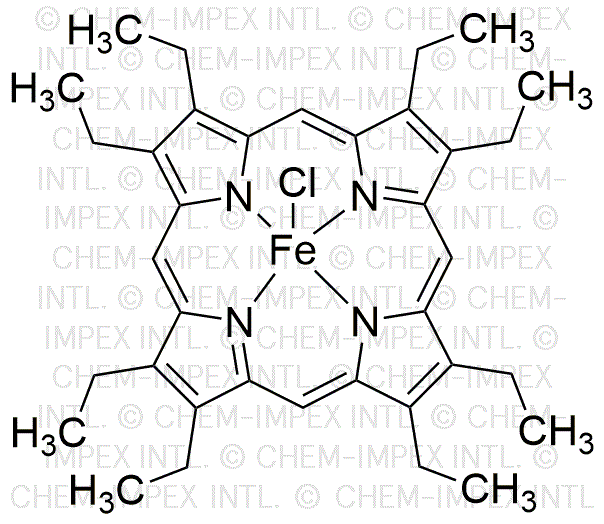Iron(III) 2,3,7,8,12,13,17,18-(octaethyl)porphyrin chloride is widely utilized in research focused on:
- Catalysis: This compound serves as a catalyst in various chemical reactions, particularly in organic synthesis, enhancing reaction rates and selectivity.
- Biomedical Applications: It is used in photodynamic therapy, where its ability to absorb light and produce reactive oxygen species can target and destroy cancer cells.
- Electrochemical Sensors: The compound is employed in the development of sensors for detecting environmental pollutants, offering high sensitivity and specificity.
- Material Science: It plays a role in creating advanced materials, such as conductive polymers, which are essential in electronics and energy storage devices.
- Research in Biochemistry: This chemical is used in studies related to heme proteins and their functions, providing insights into biological processes and potential therapeutic targets.
General Information
Properties
Safety and Regulations
Applications
Iron(III) 2,3,7,8,12,13,17,18-(octaethyl)porphyrin chloride is widely utilized in research focused on:
- Catalysis: This compound serves as a catalyst in various chemical reactions, particularly in organic synthesis, enhancing reaction rates and selectivity.
- Biomedical Applications: It is used in photodynamic therapy, where its ability to absorb light and produce reactive oxygen species can target and destroy cancer cells.
- Electrochemical Sensors: The compound is employed in the development of sensors for detecting environmental pollutants, offering high sensitivity and specificity.
- Material Science: It plays a role in creating advanced materials, such as conductive polymers, which are essential in electronics and energy storage devices.
- Research in Biochemistry: This chemical is used in studies related to heme proteins and their functions, providing insights into biological processes and potential therapeutic targets.
Documents
Safety Data Sheets (SDS)
The SDS provides comprehensive safety information on handling, storage, and disposal of the product.
Product Specification (PS)
The PS provides a comprehensive breakdown of the product’s properties, including chemical composition, physical state, purity, and storage requirements. It also details acceptable quality ranges and the product's intended applications.
Certificates of Analysis (COA)
Search for Certificates of Analysis (COA) by entering the products Lot Number. Lot and Batch Numbers can be found on a product’s label following the words ‘Lot’ or ‘Batch’.
*Catalog Number
*Lot Number
Certificates Of Origin (COO)
This COO confirms the country where the product was manufactured, and also details the materials and components used in it and whether it is derived from natural, synthetic, or other specific sources. This certificate may be required for customs, trade, and regulatory compliance.
*Catalog Number
*Lot Number
Safety Data Sheets (SDS)
The SDS provides comprehensive safety information on handling, storage, and disposal of the product.
DownloadProduct Specification (PS)
The PS provides a comprehensive breakdown of the product’s properties, including chemical composition, physical state, purity, and storage requirements. It also details acceptable quality ranges and the product's intended applications.
DownloadCertificates of Analysis (COA)
Search for Certificates of Analysis (COA) by entering the products Lot Number. Lot and Batch Numbers can be found on a product’s label following the words ‘Lot’ or ‘Batch’.
*Catalog Number
*Lot Number
Certificates Of Origin (COO)
This COO confirms the country where the product was manufactured, and also details the materials and components used in it and whether it is derived from natural, synthetic, or other specific sources. This certificate may be required for customs, trade, and regulatory compliance.


